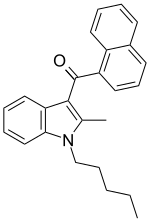JWH-007
JWH-007 is an analgesic chemical from the naphthoylindole family, which acts as a cannabinoid agonist at both the CB1 and CB2 receptors. It was the most active of the first group of N-alkyl naphoylindoles discovered by the team led by John W Huffman, several years after the family was initially described with the discovery of the N-morpholinylethyl compounds pravadoline (WIN 48,098), JWH-200 (WIN 55,225) and WIN 55,212-2 by the Sterling Winthrop group.[1] Several other N-alkyl substituents were found to be active by Huffman's team including the n-butyl, n-hexyl, 2-heptyl, and cyclohexylethyl groups,[2] but it was subsequently determined that the 2-methyl group on the indole ring is not required for CB1 binding, and tends to increase affinity for CB2 instead.[3][4] Consequently, the 2-desmethyl derivative of JWH-007, JWH-018, has slightly higher binding affinity for CB1, with an optimum binding of 9.00 nM at CB1 and 2.94 nM at CB2, and JWH-007 displayed optimum binding of 9.50 nM at CB1 and 2.94 nM at CB2.[5]
 | |
| Legal status | |
|---|---|
| Legal status |
|
| Identifiers | |
IUPAC name
| |
| CAS Number | |
| PubChem CID | |
| ChemSpider | |
| CompTox Dashboard (EPA) | |
| Chemical and physical data | |
| Formula | C25H25NO |
| Molar mass | 355.481 g·mol−1 |
| 3D model (JSmol) | |
SMILES
| |
InChI
| |
| (verify) | |
Another drug similarly named JHW-007 (not JWH) is a cocaine analog (the di-para-fluoro benztropine, being essentially a hybrid between benzatropine and difluoropine; with fluorine groups in the former or being descarbmethoxy in the latter) and atypical dopamine reuptake inhibitor,[6] but is distinct from and not the same as this JWH-007.[7]
Legal status
In the United States, all CB1 receptor agonists of the 3-(1-naphthoyl)indole class such as JWH-007 are Schedule I Controlled Substances.[8]
JWH-007 was banned in Sweden on 1 October 2010 as a hazardous good harmful to health, after being identified as an ingredient in "herbal" synthetic cannabis products.[9][10]
JWH-007 is illegal in Poland since 08.06.2010 on the basis of 'Ustawa z dnia 15 kwietnia 2011 r. o zmianie ustawy o przeciwdziałaniu narkomanii' published in Dz.U. 2011 nr 105 poz. 614[11]
As of October 2015 JWH-007 is a controlled substance in China.[12]
See also
References
- Compton, D. R.; et al. (1992). "Aminoalkylindole analogs: cannabimimetic activity of a class of compounds structurally distinct from delta 9-tetrahydrocannabinol". The Journal of Pharmacology and Experimental Therapeutics. 263 (3): 1118–1126. PMID 1335057.
- Huffman, JW; Dong, D (1994). "Design, Synthesis and Pharmacology of Cannabimimetic Indoles". Bioorganic & Medicinal Chemistry Letters. 4 (4): 563–566. doi:10.1016/s0960-894x(01)80155-4.
- Huffman, J.; et al. (2005). "Structure-activity relationships for 1-alkyl-3-(1-naphthoyl)indoles at the cannabinoid CB(1) and CB(2) receptors: steric and electronic effects of naphthoyl substituents. New highly selective CB(2) receptor agonists". Bioorganic & Medicinal Chemistry. 13 (1): 89–112. doi:10.1016/j.bmc.2004.09.050. PMID 15582455.
- Huffman, J. W.; Padgett, L. W. (2005). "Recent developments in the medicinal chemistry of cannabimimetic indoles, pyrroles and indenes". Current Medicinal Chemistry. 12 (12): 1395–1411. doi:10.2174/0929867054020864. PMID 15974991.
- Aung, M. M.; et al. (2000). "Influence of the N-1 alkyl chain length of cannabimimetic indoles upon CB(1) and CB(2) receptor binding". Drug and Alcohol Dependence. 60 (2): 133–140. doi:10.1016/S0376-8716(99)00152-0. PMID 10940540.
- Rothman, Richard B.; Baumann, Michael H.; Prisinzano, Thomas E.; Newman, Amy Hauck (2008). "Dopamine transport inhibitors based on GBR12909 and benztropine as potential medications to treat cocaine addiction". Biochemical Pharmacology. 75 (1): 2–16. doi:10.1016/j.bcp.2007.08.007. ISSN 0006-2952. PMC 2225585. PMID 17897630.
- Velázquez-Sánchez, Clara; García-Verdugo, José M.; Murga, Juan; Canales, Juan J. (2013). "The atypical dopamine transport inhibitor, JHW 007, prevents amphetamine-induced sensitization and synaptic reorganization within the nucleus accumbens". Progress in Neuro-Psychopharmacology and Biological Psychiatry. 44: 73–80. doi:10.1016/j.pnpbp.2013.01.016. ISSN 0278-5846. PMID 23385166.
- : Schedules of controlled substances
- Swedish Code of Statutes Regulation (2010:1086).
- Swedish Code of Statutes Regulation (2010:1086). (pdf)
- "Ustawa z dnia 15 kwietnia 2011 r. o zmianie ustawy o przeciwdziałaniu narkomanii ( Dz.U. 2011 nr 105 poz. 614 )". ISAP. Retrieved 12 June 2011.
- "关于印发《非药用类麻醉药品和精神药品列管办法》的通知" (in Chinese). China Food and Drug Administration. 27 September 2015. Retrieved 1 October 2015.